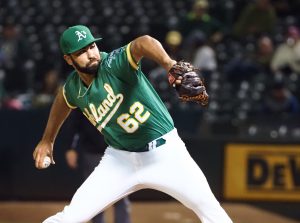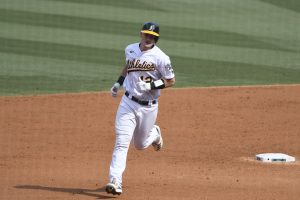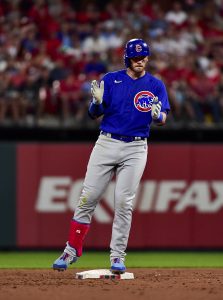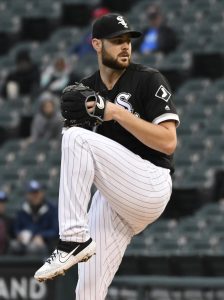For the past few seasons, there’s been loose deadline speculation around the possibility of the Royals dealing Whit Merrifield. To this point, Kansas City has resisted that possibility. A career-long member of an organization that is generally among the game’s most loyal, Merrifield was a late-bloomer who signed an affordable early-career extension. That allowed the Royals to keep him at little cost through his prime seasons, which included consecutive MLB-leading hit totals in 2018-19 and a pair of All-Star appearances.
As recently as last season, Merrifield participated in the Midsummer Classic. He went on to appear in all 162 games, led baseball with 42 doubles and swiped an AL-best 40 bases. The Royals hoped he’d be a top-of-the-order sparkplug for a more competitive team in 2022, but that hasn’t panned out. Not only has the team found itself 20 games below .500 at the All-Star Break, Merrrifield is having a career-worst season. He owns a .240/.292/.343 line through 373 plate appearances, offense that checks in 22 percentage points below league average by measure of wRC+.
Merrifield is signed through the end of next season. The Royals restructured his deal during Spring Training, so he’s making $7MM this year (about $2.73MM of which will be paid out after the August 2 deadline) and $6.75MM next season. The deal also contains a $500K buyout on a 2024 mutual option. With the affordable control and Merrifield’s trade value at a low ebb, the Royals don’t have to force a trade over the next two weeks. Nevertheless, Jon Heyman of the New York Post wrote last month the club was more amenable to dealing him than they’ve been in years past.
Even during a down year, Merrifield should draw attention from other clubs. He remains a high-contact bat and an excellent baserunner, having stolen 14 more bags while being caught just twice. He’s typically a solid defender at both second base and in the corner outfield, although public metrics are down a bit on his first-half performance in that regard. Merrifield has also looked more like himself of late, hitting .269/.322/.392 with 15 doubles and 11 steals in 65 games since the start of May. His April was abysmal, but he’s been productive for the past two and a half months and has a quality career body of work.
If the Royals were to seriously market Merrifield over the next two weeks, which teams stand out as the best fits? With a season and a half of remaining control, it’ll have to be a team that realistically feels it can compete by 2023. The Pirates, Reds, A’s, Cubs, Diamondbacks and Nationals can probably be ruled out on that alone. The Rockies and Rangers have their sights set on competing next year, but neither is likely to preemptively acquire a second baseman this summer. The Tigers are perhaps a bit more plausible given the tough season they’ve gotten from Jonathan Schoop, but they’re going to be more focused on dealing some players than acquiring a notable veteran from a division rival with an eye towards 2023.
Of the remaining two-thirds of the league’s teams, which seem likeliest to be in touch with Royals president of baseball operations Dayton Moore and general manager J.J. Piccolo?
Best Fits
Mariners — Seattle has won 14 in a row to go into the All-Star Break owners of a 51-42 record. It’s still an uphill battle to catch the Astros in the AL West, but they’re firmly in the Wild Card mix and likely to look for ways to upgrade over the next two weeks. No position stands out more than second base, where Seattle has gotten a collective .212/.279/.299 line. Offseason acquisition Adam Frazier has underwhelmed, as has last year’s deadline pickup Abraham Toro. The M’s could move Ty France to second base, but he’s better suited for first base/designated hitter duty. Frazier’s headed towards free agency after this season anyhow, and Merrifield could be an affordable upgrade for both the remainder of this season and next.
White Sox — The White Sox have had a generally underwhelming season, but they’re coming out of the Break just three games back in the AL Central. The second base tandem of Leury García and Josh Harrison hasn’t panned out, although Harrison has been alright over the past month. Merrifield would still be a definitive upgrade there, and his relatively modest salary should be particularly appealing to a team already sporting a franchise-record payroll. Would the Royals be willing to deal Merrifield inside the division? They’d surely like to compete next season, so perhaps that’ll give them some hesitance, but he’d only be under contract for one season of plausible contention.
Dodgers — Heyman reported last week that the Dodgers have already been in touch with the Royals. Second base isn’t really a need for L.A., with former top prospect Gavin Lux enjoying his awaited breakout season. Lux has seen some time in left field of late while the Dodgers have been without Chris Taylor, though, and their offseason pickup of Hanser Alberto as a righty-hitting utilityman hasn’t worked. Landing Merrifield may lead to a bit of a position player surplus once Taylor returns from the injured list, but the Dodgers haven’t been deterred by having “too much talent” in recent years.
Giants — The Giants are in a similar boat as their archrivals. They have a handful of second base-caliber players, and righties Wilmer Flores and Thairo Estrada are playing well. Tommy La Stella is off to a rough start after opening the year on the injured list, and the Giants have already been tied to Brandon Drury. That suggests they’re open to adding another righty-swinging versatile infielder. Merrifield doesn’t have Drury’s power, but his high-contact game may be a better fit for Oracle Park.
Brewers — The Brewers are expected to look for another bat this summer as they battle the Cardinals at the top of the NL Central. Kolten Wong has been a slightly below-average hitter this year, and his public defensive metrics have tumbled. That’s not too dissimilar from Merrifield, and perhaps Milwaukee will feel he’s not much (if any) of an upgrade over Wong. However, Bob Nightengale of USA Today recently wrote that the Brew Crew could listen to offers on Wong even as they look for other ways to add to the offense.
Longer Shots
Orioles — The Orioles are within 3 1/2 games of a Wild Card spot despite their second basemen hitting only .196/.269/.363. Rougned Odor is just a stopgap, and the O’s are likely to look for a better second baseman this offseason. Actually reaching the playoffs this year is unlikely, but Merrifield is affordable and would be a good fit for a 2023 team that could more earnestly compete. With the 2022 club at least hanging around, there’s an argument for GM Mike Elias and his staff to strike a little early for a controllable player.
Angels — It’s a similar argument for the Angels, although their involvement in the bidding would be strictly about 2023. The Halos have gotten nothing from second base this year, one of the reasons they’re set to miss the playoffs again. Next season will be a turning point, with Shohei Ohtani slated to reach free agency after the year. They’re going to have to aggressively address the roster’s flaws over the next eight months. Nothing stops them from adding controllable players this summer while still dealing rentals like Noah Syndergaard and Michael Lorenzen.
Rays — The Rays haven’t gotten much out of second base this year, but that’s largely because Brandon Lowe missed more than a month. With Lowe back, the keystone is no longer a concern, although Tampa Bay’s myriad outfield injuries could cause them to look at a versatile infield/outfield type.
Braves — Atlanta hasn’t gotten much from Orlando Arcia since Ozzie Albies broke his foot. They acquired Robinson Canó as a stopgap and anticipate Albies returning late next month. That probably reduces the urgency to add a second baseman, although they’re in a tight battle with the Mets and could work Merrifield into the corner outfield once Albies returns.
Phillies — Continuing the theme of “contenders whose second basemen got hurt,” the Phils have been without Jean Segura since May. He’s expected back this year, though, and the presence of top prospect Bryson Stott gives Philadelphia some cover until then. Bullpen or center field help seems likelier.
No Pressing Second Base Need
Each of the Yankees, Twins, Marlins, Mets, Astros, Guardians, Cardinals, Blue Jays, Padres and Red Sox have everyday second basemen locked into the lineup. Merrifield’s ability to play the corner outfield could make him an option for some of this group — the Yankees and Padres, in particular, could look into outfield additions — but they seem less likely to be motivated than teams searching for a second baseman. Much of Merrifield’s appeal lies in his defensive flexibility, and pigeon-holing him into the corner outfield reduces a good bit of his value. Contenders looking for an impactful corner bat to upgrade the middle of the order seem likely to find cleaner fits elsewhere.
Merrifield’s vaccination status also impacts some teams’ pursuits, most notably the Blue Jays. He was not permitted to travel to Canada for the Royals series in Toronto last week, and similar concerns reportedly diminished the Yankees’ interest in teammate Andrew Benintendi. Merrifield told reporters he’d be open to reconsidering his stance on getting vaccinated if dealt to a playoff contender that could have to travel across the border for meaningful games. He stopped short of firmly declaring he’d do so, however, and questions about his availability for those games could be of concern for some teams.
There’s no guarantee the Royals will actually follow through on a Merrifield trade. This is far from the first time his name has made the rounds on the rumor circuit, and Kansas City has yet to pull the trigger on a deal (or seemingly come close). If the front office takes a different approach this summer, teams like the Mariners, White Sox, Dodgers, Giants and Brewers feel like the most plausible suitors.

 However, there’s actually not that much of a difference to previous seasons. His 8.5% barrel percentage on the year is just barely above the 7.8% he had last year and actually below the 10.5% rate of 2020. His 41.5% hard hit percentage is the highest he’s ever had, but not drastically higher than the 35.7% rate of his career overall. His 13.6% HR/FB rate is above the 10.8% rate of prior seasons, but again, by a reasonable margin. A major factor seems to be luck, as Trivino’s batting average on balls in play this year is a whopping .468, well above the league .285 league average for relievers this year and Trivino’s .275 mark coming into the season.
However, there’s actually not that much of a difference to previous seasons. His 8.5% barrel percentage on the year is just barely above the 7.8% he had last year and actually below the 10.5% rate of 2020. His 41.5% hard hit percentage is the highest he’s ever had, but not drastically higher than the 35.7% rate of his career overall. His 13.6% HR/FB rate is above the 10.8% rate of prior seasons, but again, by a reasonable margin. A major factor seems to be luck, as Trivino’s batting average on balls in play this year is a whopping .468, well above the league .285 league average for relievers this year and Trivino’s .275 mark coming into the season.

 Giolito, with his excellent results in recent years and extra control, is perhaps the team’s best shot at really cashing in. One slight problem is that Giolito, like the White Sox, is having a down season. From 2019 to 2021, he put up an ERA of 3.47 over 72 starts, with a 30.7% strikeout rate, 8% walk rate and 35.6% ground ball rate. This year, through 16 starts, his ERA has jumped up to 4.69. His 27.1% strikeout rate and 8.5% walk rate are a bit worse than recent seasons, but not by much. BABIP seems to be a factor here, as his .338 mark on the season is well above his .272 career rate. That’s not pure bad luck, however, since he’s definitely getting hit harder. His 10.4% barrel rate is well above last year’s 6.7% and the 5.6% from the year before. Giolito is only in the 19th percentile of pitchers in terms of hard hit percentage and 29th in terms of average exit velocity.
Giolito, with his excellent results in recent years and extra control, is perhaps the team’s best shot at really cashing in. One slight problem is that Giolito, like the White Sox, is having a down season. From 2019 to 2021, he put up an ERA of 3.47 over 72 starts, with a 30.7% strikeout rate, 8% walk rate and 35.6% ground ball rate. This year, through 16 starts, his ERA has jumped up to 4.69. His 27.1% strikeout rate and 8.5% walk rate are a bit worse than recent seasons, but not by much. BABIP seems to be a factor here, as his .338 mark on the season is well above his .272 career rate. That’s not pure bad luck, however, since he’s definitely getting hit harder. His 10.4% barrel rate is well above last year’s 6.7% and the 5.6% from the year before. Giolito is only in the 19th percentile of pitchers in terms of hard hit percentage and 29th in terms of average exit velocity.